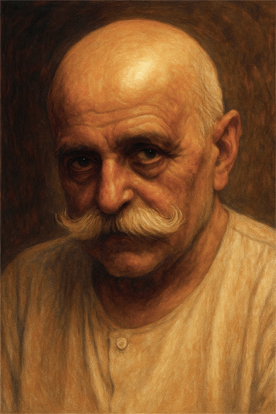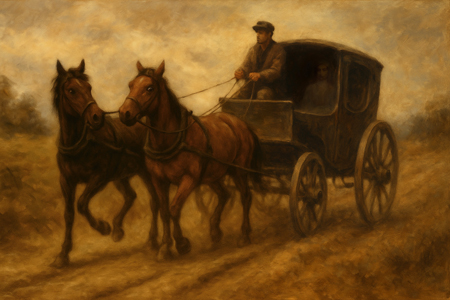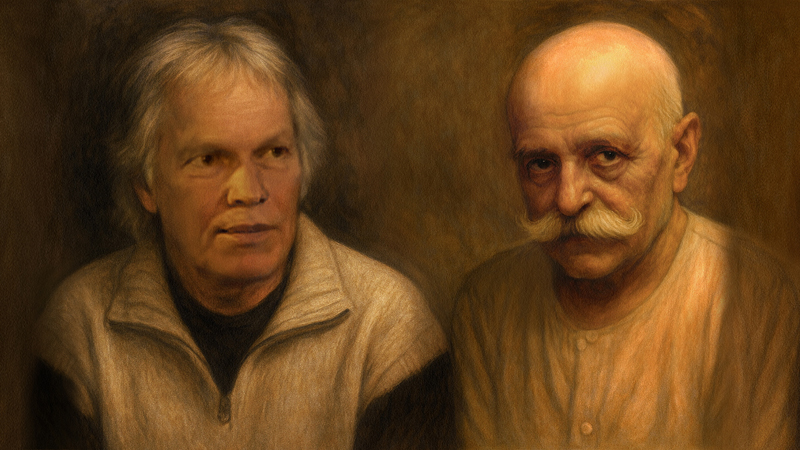Gurdjieff’s carriage
The fictional interview below I wrote based on a long-standing metaphor from the Katha Upanishad. I first heard this allegory in a simple version around the age of 17, as if it had been conceived by Gurdjieff. At that time, it was my ‘wake-up call’, leading me onto the path of spiritual philosophy.
Now, I have rewritten this allegory in the form of an interview with Gurdjieff, much more detailed than Gurdjieff’s version and certainly more detailed than can be read in the Katha Upanishad. Depth and many nuances have been added. As a result, this ‘interview’ as a metaphor provides as complete a picture as possible of the state of our human mind.
 Interview with Georgi Ivanovitsj Gurdjieff
Interview with Georgi Ivanovitsj Gurdjieff
.
Dear Mr. Gurdjieff, I have some questions about something I heard.
Just call me Georgi, my friend.
Oh, thank you!
I heard that you compare man to a carriage pulled by horses. Can you explain this concept to me?
Certainly, I’d love to. But know that this allegory I’ve developed was originally written simply in a very old scripture: the Katha Upanishad. In it, humans are already represented as a carriage drawn by horses, guided by a charioteer. But who still knows or reads this? Time continually buries wisdom, so even the best teachings become dogmas or are assimilated into religion. A true teacher must essentially be an archaeologist, rediscovering and passing on pure teachings.
Is the carriage allegory one of these pure teachings?
Indeed it does, and it is powerful because of the depth within its simple image. I often travelled by carriage—to various places with interesting and wise people. These were often long rides during which this metaphor would come back to me, as an eye-opener. During those journeys, I had plenty of time to reflect on it and develop it further.
How did you refine it?
Well, I can compare my own body to a carriage. Just as a carriage allows me to move and encounter all sorts of things, my body allows me to move through life. My body is a vehicle—the vehicle of my spirit and soul. It enables me to travel through my existence.
And that’s all?
Oh no! That’s just the beginning. The carriage is, of course, pulled by horses. And horses, as you know, are sensitive creatures, representing feelings, emotions, desires, and compulsive tendencies. Without them, the carriage would not move. Originally there were five, symbolizing the five senses. But they can also be two, representing duality and our tendency to chase after our senses, sometimes even in different directions. Horses are easily startled and distracted and then they can start doing strange things. Because they are connected to the carriage by the drawbars, the carriage is therefore under their influence.
Well, isn’t there someone holding the reins?
Indeed! The charioteer. He keeps the horses calm and guides them along the best path forward—the carriage track. You see, in the old days there were no paved roads, only ruts made by wheels, tracks that provided a somewhat comfortable ride. Off the tracks it was rough and bumpy. The charioteer represents our reason, our intellect, and our faculty of discernment. He guides the horses—our feelings, desires, and drives—along this track. The reins stand for the insights and tactics of our functional thinking that make it possible to steer the horses.
Alright, that seems clear. Is there more to say? For instance, who sits inside that carriage?
A good question! Who sits in the carriage? It is someone who is being driven and should instruct the coachman. Let’s call him the Resident. In fact, this Resident does nothing. He is an observer, a witness. He watches over the entire carriage system, the ride, and the surroundings. The Resident is the Observer. But because he is the Resident, the charioteer must carry out his orders—guiding the horses properly and ensuring that the carriage moves smoothly toward its destination.
Well, that seems like a clear metaphor. But what good is it to us?
Let me tell you. As I’ve described it to you now—as a carriage smoothly moving toward its destination—that’s not how it is in practice! The state of man is pitiful!
What???
Look, we hardly maintain the carriage properly. We don’t oil the wheels in time, the frame is barely maintained, and we polish only the outside. Many parts rust or wear out, and we mistreat the carriage. Sometimes it’s even on the verge of collapsing… But there’s more… The horses can go in almost any direction without guidance. They’re stubborn, restless, or stressed—and often rebellious. As a result, the carriage constantly veers off the track, making the already rickety thing endure rough terrain and heavy strain.
But there’s still a charioteer, isn’t there?
Certainly, but he’s often asleep. Or he’s busy with other things instead of his task. Nowadays he’d be fiddling with his smartphone all day, paying no attention to his horses at all. This charioteer intervenes far too little. He should, through proper knowledge, calm the horses and guide them back to the track. But being stubborn, he lets things run wild—or even drives the horses harder, under the illusion that he’s ‘doing well,’ while in truth he lacks any real knowledge of how to drive.
Then how can the coachman acquire true knowledge?
Ideally, by following the instructions of the Resident. For the Resident knows where to go and how to get there. Without following this true knowledge, the whole carriage system becomes a kind of unguided projectile. That makes it very likely that all sorts of difficulties and malfunctions will occur. The Resident can keep the charioteer on the track through his guidance—but only if this coachman listens!
What does the carriage track represent in this allegory? I don’t quite get that…
The carriage track stands for the Now—the only relevant moment. Now is the eternal moment in which everything happens and in which it can always be clear what we must do or not do. To go off the track means to lose awareness of the Now. We then enter the wilderness of an imagined non-Now—of a faded past or an imaginary future—where nothing can happen. Everything happens only in the Now. And imagination is usually a poor advisor.
How do we end up in that non-Now?
Well, because the horses become restless due to something that approaches from outside—something that startles or hurts them. Then they bolt and leave the track. But it can also happen through attraction—through their desires—driving them to seek satisfaction again and again, which can lead to addiction.
And the coachman?
He does nothing… or too little. He should be watchful and feel responsible for the horses. But he’s asleep… inattentive, and stubbornly refuses to listen to the Resident. The horses therefore receive no proper attention. For years they’ve also been given the wrong ‘food,’ leaving them in poor condition, impulsive, or driven by craving—which harms them as well. Naturally, the carriage also suffers, making it hard to reach its destination.
My goodness… The way you describe it, man as this whole system is in bad shape. You’re basically saying the entire human system malfunctions.
You’ve seen it well! But this dysfunction—this imbalance from which even illness can arise—is fairly simple to repair. Yet one condition must be met first: our whole system must come to rest, because what is always lacking is Silence.
Oh yes? How should we go about that?
The charioteer must start listening to the Resident. He must listen to true knowledge—not stubbornly follow his own little world of ideas and merely ‘do something.’ For in that stubbornness, everything on his path happens to him instead of him calmly seeing it coming and acting accordingly.
How did things get this way?
Well, the root of all this misery is simply that the Resident is not known at all—though he is precisely the one who could meaningfully manage the entire system. The one whom the coachman should at least obey. Because of this ignorance, the entire carriage system is in danger—vulnerable to random circumstances, or to others who hijack it for their own gain, taking no responsibility for the state in which they leave it.
Could you summarize it for me once more, Georgi?
 Gladly. Here it is: This carriage metaphor represents every individual.
Gladly. Here it is: This carriage metaphor represents every individual.
The Resident—the Self—is the same for everyone. There is only one Resident, no matter how many carriages exist. There is only one Self, no matter how many individuals exist. In pure awareness of the Now—on the carriage track, so to speak—our reason is the mental instrument that guides our desires and feelings. Acting from true knowledge, coming from the Self, our reason will act in alignment with what is truly known. Without that, the charioteer cannot steer rightly. His compass should be common sense. But often it is not. He even ignores the compass the horses could provide when they move calmly, for horses, through natural intuition, sense which path to take and at what pace. Healthy horses, through sound feeling, have an intuitive connection with the Resident. Yet this is easily disturbed by external circumstances and by the stubbornness of the coachman, since neither are trained and they’ve been given the wrong nourishment.
So the horses could actually do much good on their own?
They certainly could! The horses—our drives and aspirations—can find their way well if they are calm and properly guided. Horses sense potential danger on the road—like a snake—long before the coachman does, for they are always alert. He must therefore pay close attention to his horses and listen carefully to their signals. Healthy horses almost naturally find their way and hardly need to be reined. Our feeling senses a great deal, for it has its own kind of lightning-fast intelligence. But if we ignore our feelings, unrest arises, and emotions easily spiral out of control. Only our reason—our intellect—can bring change here, but only when acting from true knowledge.
And how does our ego fit into this story?
Our ego has not yet been identified in this metaphor—so let me do that now. When we are not connected with our Self, we act inadequately or erratically. Then our coachman takes up the whip or does other foolish things that stir up even more unrest. This is our ego: a stubborn, ignorant coachman who lacks true knowledge. He misguides or neglects the horses—or even drives them mad. He identifies with all sorts of personal quirks, saying, “this is me.” But to identify ourselves with something is to make it our identity, even though that’s impossible. The system then follows its own separate ego-path, leaving the track of the Now, bumping into obstacles or sinking into quicksand. Naturally, our body-carriage suffers, becoming ill or even dying. Needless to say, both our reason and our emotional world suffer as well.
What do you mean by obstacles and quicksand?
Obstacles and quicksand are all the outer and inner circumstances we encounter and to which we react mechanically in thought, feeling, and action—simply because we fail to remain present in the Now. We sink into projections of a bygone past or an imaginary future. This identification and projection cause mechanical thinking—experienced as endless churning in the head. Our attachments, desires, and unnoticed mental drivers—like assumptions and prejudices—keep our attention imprisoned in a non-existent reality. They lead us into trouble and chase away a natural experience of joy.
Good heavens… what a story! It doesn’t look good for humanity, does it…
You’re right. People are functioning far below its potential. Mainly because the mind is not clear. Through all the turmoil that mechanical thinking and feeling bring, they keep identifying with anything and everything, completely forgetting that someone actually is inside the carriage. Forgetting who he truly Is. That he is the Self. So for humans this applies:
His so-called ‘common sense’ has become unhealthy due to sleep, disinterest, stubbornness, and the constant illusion of separateness.
His feelings have lost their natural intuitive connection with conscience and are unhealthy because he does not listen to them—thus old emotions, pain, and addictions never dissolve.
His body is unhealthy—addicted, weakened, or obese—and endangered because it receives neither proper nourishment nor care.
Through this allegory you have now also encountered what my Fourth Way stands for: the purification of head, heart, and body. So keep asking yourself:
Is our coachman truly wise and leading? Or is he stubborn and asleep?
Do our horses still find ‘the way’ naturally? Or are they stressed or blunted?
Is our carriage still strong and vital? Or is it slowly collapsing?
And what about the Passenger? The Self?
Ah… the Self couldn’t care less, to be honest—it knows no struggle or striving and merely observes. The Self is always at peace. The Absolute knows no opposition. It Knows. That Knowledge is always available to those who are open to it. True Knowledge will recognize and avoid the quicksand of identifications. It leads the carriage from the rough terrain of unwanted conditions back to the balance of the track—to the Now. Always. The Self is within us because we Are It. As individuals, we only need to follow.
What should we do first?
We must become ‘radical’—a term derived from the Latin radix, meaning root. We must ‘convert’ in a radical way: turn inward in self-reflection and direct ourselves toward the ‘root of liberation.’ That keeps us from the discord of the head, the discontent of the heart, and the illness of the body.
I get it now! I can see it clearly. A famous person once said, you only start seeing it once you get it. Wonderful! Thank you so much!
You’re most welcome, my friend.
.
Georgi Ivanovich Gurdjieff (1866 – 1949) was a Greek-Armenian philosopher, mystic, writer, and composer

